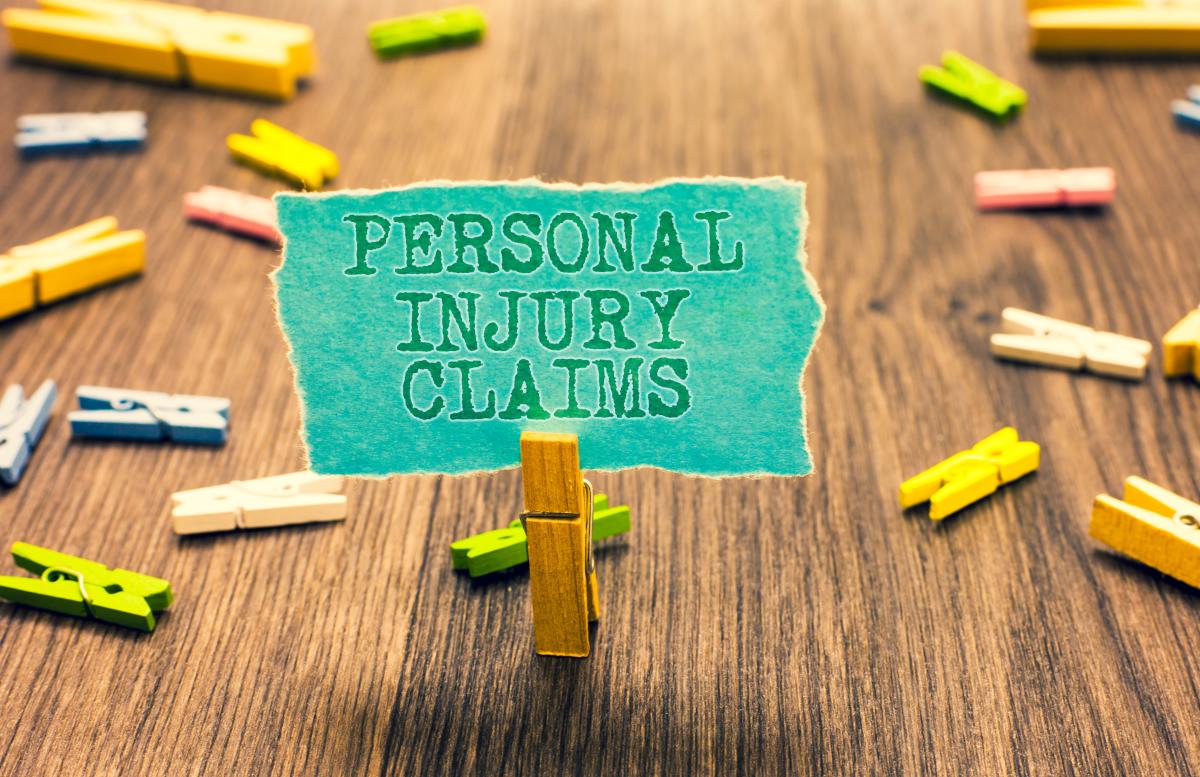Types of Personal Injury Claims [2024]

Personal injury occurs when someone suffers physical, mental, or emotional damage due to either the negligence or intentional misconduct of another person. It may also include injury to one’s reputation. In the U.S., personal injury claims make up a major portion of civil litigation. A personal injury claim is a civil action brought by the injured party against the party responsible for harming them. It is estimated that over 440,000 personal injury lawsuits are filed each year in the United States. According to recent data from the U.S. Department of Justice, Bureau of Justice Statistics, roughly only 4% of those lawsuits actually go to trial. Frequently, these types of cases are settled out of court. In some instances, they may also be dropped by either the claimant, the insurance company, or the judge. If you or a loved one have experienced some form of personal injury at the hands of another entity, you may be wondering if you are entitled to compensation for your injuries. Read on to learn more about common types of personal injury claims and what your legal options are.
Common Personal Injury Claims
There are so many types of personal injury that can befall a person. These injuries can range from minor to severe to deadly. They can have long-lasting impacts on a person’s physical, emotional, and financial well-being long after injuries occur. Below is a list of some of the most common examples of personal injury claims. It is by no means exhaustive. Whether or not you see your type of injury listed here, it’s a good idea to reach out to an experienced personal injury attorney to discuss your situation.
Motor Vehicle Accidents
Motor vehicle accidents are one of the most common types of personal injury claims. According to Statista, there were around 282 million motor vehicles registered in the United States in 2021, including trucks, buses, motorcycles, and passenger cars, among other types of motor vehicles. The National Safety Council (NSC) estimates that in 2021, almost 47,000 people died in motor vehicle accidents, and that same year, there were around 5.4 million medical consultations in relation to injuries acquired from motor vehicle crashes. Some of the most common causes of motor vehicle accidents are:
Driving under the influence of drugs or alcohol
Speeding
Texting or otherwise using a cell phone while driving
Reckless driving
Not wearing a seatbelt
Medical Malpractice
Medical malpractice is a term that encompasses all manner of mistakes made by medical practitioners, ranging across varying degrees of seriousness and commonality. It is defined as an act or omission by a healthcare professional or facility during a patient’s treatment that differs from the generally accepted standards of care and which results in personal injury (or death) for the patient. It is typically deemed to be a result of negligence on the part of the associated medical practitioner(s). Here are some of the more common forms of medical malpractice:
Failure to Diagnose -or- Misdiagnosis
Anesthesia Errors
Surgical Mistakes
Post-Op Negligence
Failure to Follow-up
Medication Mistakes
Childbirth Injuries or Mishaps
Premises Liability
Premises liability involves accidents that take place on someone else’s property. It could be the property of an individual or a business. One of the most common types of accidents that occurs under this category is slip-and-falls. Falls are one of the top three causes of unintentional, injury-related deaths in the U.S. and the number one cause of non-fatal injuries, according to the National Safety Council. Some other types of injuries that fall under this category include, but are not limited to, the following:
Fires
Elevator or escalator accidents
Improper or inadequate premises maintenance
Swimming pool incidents
Product Liability
With product liability, designers, manufacturers, distributors, retailers, and other entities who are responsible for making products available to consumers may be held responsible if those products cause injuries. Often, mass torts fall under the purview of this type of liability. Examples of some of the causes of injuries related to product liability are:
Poor designs
Manufacturing defects
General product malfunctions
Inadequate or complete lack of warning labels
Toxic or hazardous materials
Unsanitary manufacturing conditions
Intentional Torts
An intentional tort is any injury caused by a purposeful or premeditated act. The person committing the act may not have intended to cause injury, such as in the case of a prank gone wrong. On the other hand, many intentional torts result from the perpetrator’s desire to inflict harm upon the injured party. Here are some common examples of intentional torts:
Assault
Battery
False arrest/imprisonment
Animal attacks/bites
Intentional infliction of emotional harm
Slander/Libel
Brain Injuries
Traumatic brain injuries, also referred to as TBIs, are a common occurrence that can have life-altering repercussions. In the United States, there were over 223,000 TBI-related hospitalizations (approximately 611 per day) in 2019 and over 69,000 TBI-related deaths (approximately 190 per day) in 2021, according to the CDC. Brain injuries can be caused by a number of occurrences, including but not limited to:
Motor vehicle accidents
Slip-and-fall accidents
Workplace injuries
Sports-related injuries
Physical attacks (assault)
Penetrating or non-penetrating (blunt) trauma
The most common causes of TBIs are falls, firearm related injuries or deaths, assaults, and motor vehicle crashes.
Birth Injuries
A birth injury refers to an impairment of the newborn’s body structure or function due to a detrimental event occurring at the time of birth. A few examples of scenarios that may lead to serious birth injuries are when doctors, nurses, and other attending medical staff are responsible for any of the following:
Neglecting to treat maternal health issues throughout the course of a pregnancy
Failure to monitor or anticipate birth complications, such as a twisted umbilical cord
Improper use of medical birthing equipment, such as forceps
Ignoring signs of fetal distress, such as changed heart rate or oxygen levels
Improper or inadequate postnatal care of mother or newborn
Wrongful Death
Wrongful death occurs when someone dies as a result of another person’s negligence or misconduct. Wrongful death lawsuits are civil actions intended to seek financial compensation for the surviving family members of whomever was wrongfully killed. Some potential causes of wrongful death may include:
Medical malpractice
Motor vehicle accidents
Product liability
Criminal behavior
Other Personal Injury Claim Examples
Other personal injuries that someone may experience and decide to take civil action for are:
Burns
Spinal cord injuries
Aviation and Boating accidents
Food poisoning
Bicycle Accidents
Workplace Accidents
How Much Is My Claim Worth?
Unfortunately, it is impossible to say ahead of time what your personal injury claim will be worth. Every lawsuit has its own particular set of circumstances, and there are so many factors that contribute to how damages in these cases are awarded, such as what kind of liability the defendant assumes, whether or not the case is being heard by a judge or a jury, if it is settling out of court, how bad the injury is, how long term the impacts of the injury will be, and whether or not the injured party contributed in any way to their own injury. Below, we’ll delve into some of the aspects of your case that may impact the ultimate outcome, and we’ll discuss the two main types of damages typically awarded in a personal injury lawsuit.
Compensatory Damages
The compensation you receive may account for both tangible and intangible damages. There are typically two main types of damages awarded in personal injury lawsuits. Compensatory damages cover all the expenses that result from your injury, including but not limited to:
Medical bills
Lost wages
Loss of future earning potential
Medical equipment and prescription costs
Special amenities needed to accommodate disabilities as a result of your injuries
Funeral costs
These types of damages also account for intangible things, such as:
Physical, emotional, and mental pain and suffering
Loss of quality of life
The more grave your injury, the more likely it is that the expenses related to it are going to add up. This will be taken into consideration when determining how much compensation you may receive.
Punitive Damages
Punitive damages may also be awarded in some cases, typically at the discretion of the court, if it is determined that the defendant needs further motivation not to commit the same harmful acts in the future. These types of damages are intended to punish the defendant and possibly to send a message to others who may be inclined to commit similar acts.
Comparative Negligence
Typically, personal injury cases are won by proving that the defendant acted negligently and/or intentionally, thus resulting in the plaintiff’s injury. When preparing a defense, the lawyer for the defendant may try to argue that you played a part in injuring yourself. Comparative negligence is the principle that the fault of each party involved in an accident depends on their individual contributions to the accident. Damages may be awarded according to each participant’s degree of fault, thus limiting how much the plaintiff may recover.
Contributory Negligence
This is another defense that your opposition’s attorney may use. The idea behind contributory negligence basically states that there was a failure of the plaintiff to act with caution, and in failing to do so, they contributed to their own injury. If this can be proven, a judge, jury, mediator, or arbitrator may choose to limit the amount of damages the plaintiff can receive.
Assumption of Risk
Assumption of Risk is a doctrine that argues that if a person undertakes an activity, understanding the dangers involved, they are knowingly assuming these risks, and they may be barred from recovering damages stemming from any injury incurred while they voluntarily exposed themselves to danger. If your injury resulted from an activity where you knowingly assumed the risks associated with that activity, the damages awarded in your case may be adversely impacted.
Pre-existing Conditions
The laws in every state are different, but generally speaking, as long as the injury is a new injury unrelated to the pre-existing condition, having a pre-existing condition should not impact the damages awarded in a personal injury case. If the new injury in some way exacerbates a pre-existing condition, it may, in fact, contribute to the argument that higher compensation is merited.
Legal Options to Help Recover Compensation
Hiring an attorney can be daunting if you’ve never done such a thing. It can also be expensive. In the case of a personal injury lawsuit, not hiring an attorney might be more costly in the long run. Their knowledge and expertise are invaluable when it comes to arguing on your behalf and ensuring that you receive the compensation you deserve. Outlined below are some of the benefits of working with an experienced and qualified lawyer.
Filing a Complaint
After your initial consultation, your attorney will begin your lawsuit by drafting and filing a complaint with the courts. A strong complaint will do the following:
Identify all parties involved
Outline the details of the case against the defendant
Give a description of your injuries
Lay out the demands for judgment/relief (What are you asking for as compensation?)
The objective of the complaint is to make the defendant aware of your factual and legal claims.
3: Sending a Written Demand
In many states, you will be required to send a written demand letter to whomever you are suing. The letter is intended to make them aware of the impending lawsuit. When writing it, explain what injuries were incurred at the hands of the defendant(s). State what compensation you are requesting and/or how much you are willing to settle for outside of court. Provide your full contact information. The letter should be mailed via certified mail, with a return receipt requested. Before you mail it, be sure to make a copy for your own records. Your attorney will be well-versed in this and will be able to help you draft an appropriate demand letter.
Filing a Summons
After the complaint has been filed, you will also need to file a summons, which is a court document telling the defendant that a personal injury lawsuit has been filed against them. Once all of the necessary paperwork has been completed, the complaint, summons, and any other relevant documents will be delivered to the defendant through a legal practice referred to as “service of process.” You will then await their reply. They should respond with an indication of whether they admit to or deny the statements in your claim. Failure to respond to a summons puts the defendant at risk of automatically losing their case. Your attorney will give you peace of mind throughout all of this by knowing exactly which court documents need to be filed, when they need to be filed, and with whom.
Going Through Discovery to Prepare for Trial
In preparation for your lawsuit, both sides will need to go through what is known as the discovery process. During this time, injury laws will be researched, claims will be investigated, and witnesses and experts may be interviewed. Whether or not your personal injury lawsuit goes to trial will depend largely on what is uncovered during the discovery process, as the information put forth directly impacts whether or not a settlement between the two involved parties can be reached during mediation or arbitration.
Proving Liability
If the parties involved cannot reach an out-of-court settlement through mediation and/or arbitration, going to trial is the next step. In a civil lawsuit, the burden of proof lies with the plaintiff. This means it will be up to your attorney to prove that the claims against the defendant are factual. They will likely do so by demonstrating negligence on behalf of the defendant. In order to do so, they will use their knowledge and expertise to gather the appropriate evidence and enlist the most relevant and qualified personal and expert witnesses.
Lawsuits are arduous, and they can be very emotional. There are so many factors that determine whether or not your lawsuit will be successful. Without the help of a lawyer, the paperwork alone can be time-consuming and confusing. Working with a knowledgeable attorney will give you the peace of mind that comes from knowing that your best interests are represented, that you are doing everything you need to be doing and that the most satisfying outcome will eventually be reached.
Expertise.com StaffAuthor
Step into the world of Expertise.com, your go-to hub for credible insights. We don't take accuracy lightly around here. Our squad of expert reviewers, each a maestro in their field, has given the green light to every single article you'll find. From rigorous fact-checking to meticulous evaluations of service providers, we've got it all covered. So feel free to dive in and explore. The information you'll uncover has been stamped with the seal of approval by our top-notch experts.




